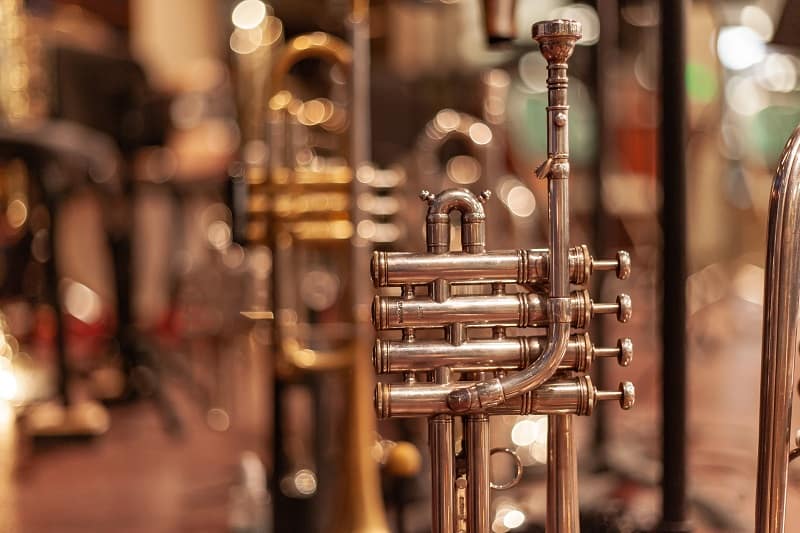Depending on the model of trumpet that you are using (standard vs. piccolo vs. natural etc.), the length and construction will be very different from one another.
Let’s have a look at the numbers:
Here is a Breakdown of Trumpet Lengths:
A standard trumpet, when coiled, is about 2 feet long: uncoiled, a standard trumpet is about 4 feet 10 inches long. A piccolo trumpet – the smallest trumpet used – is about 2 feet 5 inches long uncoiled. For reference, a trombone is about 9 feet when you uncoil its tubing.
Table of Contents

1. What Are the Dimensions of a Standard Trumpet?
The standard B♭ trumpet is what most players use and learn on.
Standard trumpets measure about 22-23 inches in length when coiled up. This means that when you are holding or playing the trumpet, it is roughly 2 feet in length long.
The bell of the trumpet is roughly 4.5 inches in diameter. However, this will differ depending on the kind of trumpet that you buy or the brand that you buy from.
The bores of the trumpet (or the internal diameter of the tube) will be about .45 inches in diameter as well.
2. How Long is the Total Length of an Uncoiled Trumpet?
The B♭ standard trumpet is actually the largest of the commonly used trumpets!
A standard trumpet is about 4 feet and 10 inches long in tubing length when uncoiled.
This twice the size of a piccolo trumpet, which is considered the smallest trumpet.
However, this is not nearly as long as the trombone, which is about 9 feet in length when uncoiled.
The longest brass instrument is the tuba which, uncoiled, measures roughly 16-18 feet long!
3. How Long is a Herald Trumpet?
The herald trumpet that we know today was most likely modeled after the buisine trumpet, a six-foot-long horn with a flared bell at the end.
Buisine trumpets were thought to be about six feet in length when held up for playing and therefore were very long and slender.
The modern herald trumpet is a little different than that now.
According to Getzen.com, the 593 Bb Herald Trumpet is roughly 31 and 1/4 inches in length, excluding the mouthpiece, which makes it about 2 and 1/2 feet long held up.
Uncoiled, it is probable that the herald trumpet is similar in length to the standard trumpet, with a length of roughly 4 feet long.
4. How Long is a Natural Trumpet?
A natural trumpet is a valveless brass instrument that makes a very simple sound, generally sticking to one overtone due to its limited construction.
When uncoiled, a natural trumpet is about 8 feet in length.
This is just a little bit shorter than a trombone which is about 9 feet in length.
5. What Are the Shortest Trumpets?
The tubing in a piccolo trumpet (particularly a B♭) is about half the length of your standard trumpet.
This means that the tubing length in a piccolo trumpet is roughly 2 feet and 5 inches long.
The piccolo trumpet is best used for the difficult parts of Baroque music in the orchestral setting and generally is pitched one octave higher than the standard trumpet.
6. How Long is the Mouthpiece?
The length of a mouthpiece on a trumpet is roughly 2 – 3 inches long, depending on the mouthpiece that you get.
Larger mouthpieces are used for lower registers (bigger horns). Therefore, smaller mouthpieces are used for higher registers or more piercing or sharp sounds, such as what you find in trumpets and especially the smaller piccolo cornets.
A 7C mouthpiece is the most common, but there are also 3C and 5C mouthpieces as well to choose from.
You can read more here about the difference between mouthpiece sizes.
Why Did the Trumpet End Up with its Current Length?
The current length of the trumpet was designed and redesigned over centuries of use.
The very first “trumpets” were simply tubes made from animal horns, ceramics, or bones and were incredibly limited in their sound capabilities. Those evolved over time to include metal like brass or silver-plated, or even gold-plated materials.
This change in materials would ultimately change the sound of the trumpet.
Natural trumpets, which are just brass and valveless versions of the trumpet used more commonly today, have a completely different sound and, throughout history, were used in military communications, such as when to retreat or break camp.
Because of its single coiled tube, it could only produce the notes of a single overtone series.
The decision to twist, change, and rework the trumpets, add valves, and increase the size of the bell was the work of many different designers and centuries’ worth of music scholars tiresome testing and reworking.
Eventually, the construction of the trumpet was settled upon around 1815, considered to be the beginning of the “modern trumpet” and therefore would be the closest in construction to the standard B♭ that we are used to today.
Why Do Trumpets Have Such Long Tubing?
Trumpets have such long tubing because the sound must be carried through in a precise way.
The longer the tubing on a standard trumpet, the more of a deeper or richer sound you will receive. For example, the piccolo trumpet has about 2 feet less tubing than a standard trumpet, and therefore is pitched one octave higher and has a higher and sharper sound.
The construction of the trumpet had been ongoing for centuries before it was officially settled that the “modern trumpet” (invented in 1815) was the best sounding version for the orchestral purpose it was trying to fulfill.
The long tubing and vibrations of sound within the trumpet create the beautiful sounds that we know and love today!
Any longer or shorter tubing within the construction would drastically change the sound of the trumpet, in the same way, that a trombone and a tuba don’t sound like a trumpet or one another.
References:
A guide to buying your first Trumpet
